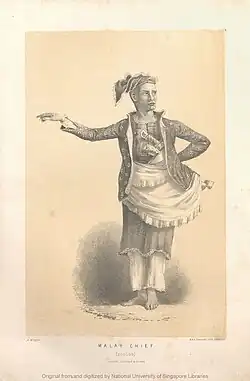Syarif Osman
| Syarif Osman شريف عثمان | |
|---|---|
 A Sulu chief, possibly Syarif Osman | |
| Reign | 1830–1846 |
| Successor | Syarif Yassin |
| Died | 1846 (disputed) |
| Spouse | Dayang Cahaya |
| Issue | Syarif Yassin Syarif Hassan Syarifa Loya |
| House | House of Osman |
| Mother | a local Bajau woman |
| Religion | Sunni Islam |
Syarif Osman[a] or referred as "Rajah of Maloodoo" by Governor Butterworth of Singapore (Missing in action c. 1845)[1] was the first and last independent Rajah of Marudu from 1830 until 1845. He would be succeeded by his son, Sharif Yassin. He is one of many heroes of Sabah.[1] Like Mat Salleh
Early life
He was of mixed Suluk-Bajau/ Bruneian Sharif descent . He was married to a Sulu princess who was the niece of the Sultan of Sulu, Sultan Jamalul ul-Azam, named Dayang Cahaya. Sharif Osman was appointed by the Sultan of Sulu to rule and collect taxes in Marudu when the area was handed over by Omar Ali Saifuddin II to the Jamalul Kiram I.
Reign
After becoming the governor of Marudu, he transformed Marudu into a kerajaan,[1] leaving his protectorate status from the Sulu Sultanate. He had strong influence on Eastern Sabah, making alliances amongst other Sabahan princes.[1] British attempts to drive the Sultan of Sulu's followers out of the region failed. And a punitive expedition by the "White Rajah" James Brooke in 1845 with the defaming reason of Marudu being a base of operations for pirates.[1]
After firing a cannon shot at the British at Kota Marudu, battle ensued, Talbot's men were exposed to cannon fire for about an hour. Of the six to eight British dead and about twenty wounded, most fell during this initial exchange of fire. It is unclear whether Osman's men fired at any significant volume afterward. Stephen Evans attributed the relatively rapid end of the battle to an operator's error by the fortress gunners[2]
Abbas/Bali explained Osman's defeat as treason and underestimation of the naval gunfire, as Osman had not expected the guns to reach his fortress. The interpretation that Osman lost the battle due to the enemy's superior force may be the most accurate. Shortly after the initial exchange of fire, Talbot landed some of his men on the right bank and aimed rockets at the fortress. The rocket party landed on the right bank and fired with good effect into the stockade.[1]
Syarif Osman likely didn't expect the British to have weapons with such a range at their disposal. The rockets caused devastating damage to the fortress. Nevertheless, the defenders tried to use the still-functioning cannons to prevent the British from penetrating the fortifications. The persistent bombardment and defense of the barrier may have been Osman's only real chance to prevent the storming of his fortress and city. What Rutter described as the devil-may-care spirit of Osman's men was more likely an expression of a desperate defense. When the British finally broke through the barrier, some hand-to-hand combat still took place, but most of the defenders probably had no doubt that the battle was finally decided. They fled, even though they might have had the best chance against the numerically inferior British in close combat. Perhaps the loss of capable fighters due to the rocket fire was too great for an effective defense.[1]
Death or wounded?
Whether Syarif Osman himself was killed during the battle is not clear from the eyewitness accounts. He was presumably wounded and carried off. Talbot made no mention of Osman's fate in his report. Cochrane reported that he was wounded, but did not know whether he was dead or alive. In a later letter to the Admiralty, Cochrane gave the impression that he assumed Syarif survived; he triumphantly stated:
"And as I believe, I have left him [Osman] with nothing but the clothes he wore, and a small house in the country to which I understand he sent his wives and children the evening before the attack, he has no means of recommencing his piratical proceedings!"
— Cochrane
Cree presumed that Osman had been wounded. Brooke, too, was unsure whether Osman was dead a day after the battle. In the Journal Mundy, he initially reported that Osman had been driven into the mountains. The newspaper Friend of China reported on September 17, 1845, that at the time of the report, ten Europeans and 30 men from Manila were still in Osman's captivity as slaves. All these reports call into question the later frequently and persistently repeated statement that Osman succumbed to his wound in the neck. The British found several Sharifs and leaders among the dead in the fortress area, but Syarif Osman was not discovered.[1]
Wright assumes that Osman fled to Tungku to join his friend Raja Laut. Some authors point out that Osman's followers fled to Tungku after the battle. Baring-Gould/Bampfylde, however, argue that in 1846 some Iranun retreated from the towns of Tempasuk and Pindusan, destroyed by Captain Mundy, to Tungku to continue their piratical activities, but the Marudu survivors settled on Palawan and in Bongon (Marudu Bay) and were therefore not directly pirates.[1]
Legacy
Syarif Osman would be the inspiration for Sandokan, as the fictional pirate also used Osman's flag which was a tiger's head on a red background.

References
Notes
- ^ His name is also spelled as Sharif Osman, Sharif Usman and Sharif Uthman